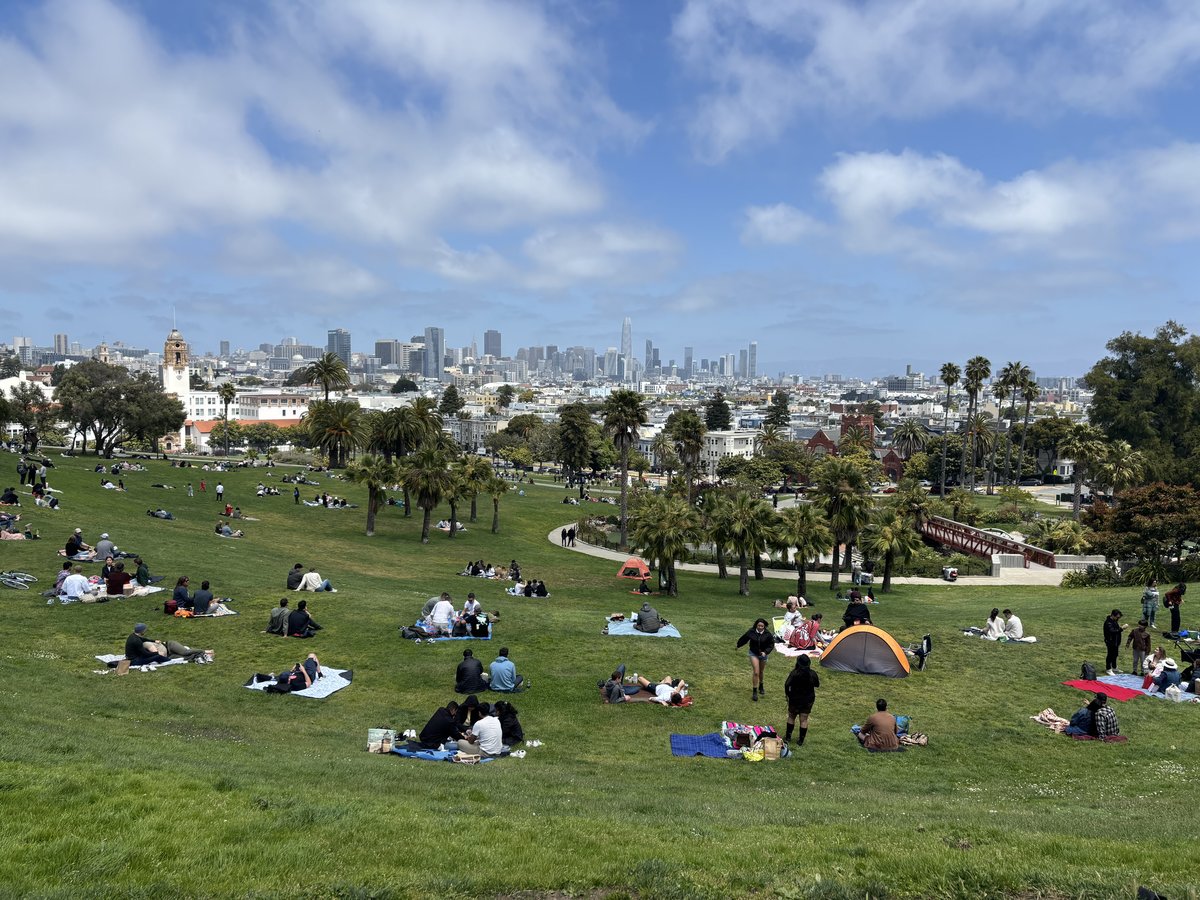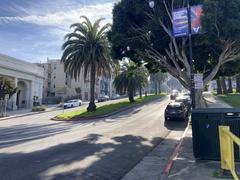
Mission Dolores Park San Francisco Visiting Hours, Tickets, and Attractions Guide
Date: 14/06/2025
Introduction
Mission Dolores Park is a vibrant urban oasis in the heart of San Francisco’s Mission District. Spanning approximately 16 acres, it is not only a beloved recreational space but also a site steeped in layers of history—from its indigenous Ohlone origins to its role as a community sanctuary following the 1906 earthquake. Today, it stands as a symbol of San Francisco’s resilience, diversity, and cultural vibrancy, drawing thousands of locals and tourists on sunny weekends. This guide provides in-depth information on the park’s history, visitor details, amenities, nearby attractions, and practical tips for a memorable visit (KALW; Wikipedia: Mission San Francisco de Asís; Curbed SF).
Table of Contents
- Indigenous Roots and Early Colonial Era
- 19th Century Transformations: Cemeteries and Urbanization
- Early 20th Century: Park Design and Community Role
- Mid-20th Century: Cultural Shifts and Preservation
- Late 20th Century to Present: Renewal and Vibrancy
- Visiting Mission Dolores Park: Hours, Tickets, and Accessibility
- Park Features and Layout
- Community Events and Cultural Significance
- Nearby Attractions
- Visitor Experience and Practical Tips
- Notable Viewpoints and Photographic Spots
- Frequently Asked Questions (FAQ)
- Summary and Recommendations
- References
Indigenous Roots and Early Colonial Era
Before Spanish colonization, the area that is now Mission Dolores Park was home to the Ramaytush Ohlone, specifically the Chutchui village of the Yelamu tribe. The Ohlone people maintained a sustainable relationship with the land for thousands of years, fishing local creeks and cultivating the environment (KALW).
With the arrival of Spanish missionaries in 1776, Mission San Francisco de Asís (Mission Dolores) was established two blocks north of the present-day park. The mission, the oldest standing building in San Francisco, was constructed largely with Ohlone labor and became the focal point of colonial activity (Wikipedia: Mission San Francisco de Asís).
19th Century Transformations: Cemeteries and Urbanization
Following Mexican secularization policies, the land’s use shifted. By the mid-1800s, it became home to Jewish cemeteries, purchased by Congregation Sherith Israel in 1861. These cemeteries operated until 1894, when increasing urbanization prompted the city to relocate burial grounds outside city limits (Curbed SF). The city then acquired the property in 1905, paving the way for its transformation into a public park (Travellingcamera).
Early 20th Century: Park Design and Community Role
Mission Dolores Park was formally established in 1905 under the guidance of John McLaren, also known for Golden Gate Park. The park’s design reflected the Progressive Era’s focus on public health and open spaces, with broad lawns, tree-lined paths, and recreational facilities (Mission Local).
The park quickly became a refuge after the devastating 1906 earthquake, sheltering thousands of displaced residents in temporary camps (Curbed SF). In subsequent decades, community groups advocated for improvements, such as paved streets and palm trees, while the addition of amenities like tennis courts and playgrounds made it a popular destination for families.
Mid-20th Century: Cultural Shifts and Preservation
From the 1940s onwards, the Mission District became a center for San Francisco’s Latino community, and Dolores Park mirrored its evolving identity. In 1966, monuments like the Mexican Liberty Bell replica and a statue of Miguel Hidalgo were installed, honoring the area’s Latino heritage (KALW). Despite proposals for new facilities, residents consistently advocated for the preservation of the park’s historic landscape, helping ensure its status as a cherished green space (Mission Local).
Late 20th Century to Present: Renewal and Vibrancy
Like many urban parks, Dolores Park experienced periods of neglect, especially in the 1980s. However, the early 21st century saw a renaissance, fueled by neighborhood revitalization and a $20.5 million renovation completed in 2016. Upgrades included new restrooms, accessible paths, and landscaping enhancements, all while preserving the park’s historic character (Wikipedia: Mission Dolores Park). Today, the park attracts up to 10,000 visitors on sunny weekends and has become an epicenter for community events and cultural expression (PPS; TripSavvy).
Visiting Mission Dolores Park: Hours, Tickets, and Accessibility
- Hours: Open daily from 6:00 AM to 10:00 PM.
- Admission: Free; no tickets required.
- Accessibility: Wheelchair-accessible paths and restrooms, with accessible parking available nearby.
- Getting There: Located at 19th and Dolores Streets, the park is easily reached via the J Church Muni line (Church & 18th) or 16th Street Mission BART station. Limited street parking is available (sfrecpark.org).
Park Features and Layout
- Grassy Lawns: Expansive, gently sloping lawns ideal for picnicking, sunbathing, and people-watching.
- Sports Facilities: Six tennis courts, a basketball court, soccer field, and multi-use court.
- Helen Diller Playground: Modern, accessible, and family-friendly.
- Dog Play Areas: Two off-leash zones at the north and south ends.
- Landmarks: The DoloRainbow Bridge, Liberty Bell replica, Miguel Hidalgo statue, and the historic golden fire hydrant.
- Restrooms and Water Fountains: Located near the playground and sports courts; accessible and well-maintained.
- Seating and Picnic Tables: Available throughout the park.
- Food Options: Nearby, try Bi-Rite Creamery, Tartine Bakery, Dolores Park Cafe, or local food vendors on busy days (sfrecpark.org; timeout.com; girleatworld.net).
Community Events and Cultural Significance
Mission Dolores Park is an active community hub, hosting annual events such as outdoor movie nights, performances by the San Francisco Mime Troupe, and celebrations like International Dog Day and Pride festivities. The park is also a frequent site of grassroots activism, reflecting the city’s commitment to social progress (PPS; TripSavvy).
Nearby Attractions
- Mission San Francisco de Asís (Mission Dolores): The oldest building in San Francisco, featuring a museum and historic cemetery (Wikipedia: Mission San Francisco de Asís).
- Clarion Alley: Famous for colorful murals.
- Valencia Street: Lined with boutiques, cafes, and restaurants.
- Dolores Street and Castro District: Offering vibrant nightlife and LGBTQ+ history.
Visitor Experience and Practical Tips
- Best Times to Visit: Weekday mornings for tranquility; late afternoons and weekends for a lively scene.
- Weather: Bring layers—San Francisco weather is unpredictable.
- Picnicking: Glass containers are prohibited; alcohol permitted in moderation.
- Safety: The park is generally safe but keep an eye on belongings and be mindful after dark.
- Dog Owners: Use designated off-leash areas and clean up after pets.
- Leave No Trace: Help keep the park beautiful by disposing of trash properly.
Notable Viewpoints and Photographic Spots
- Upper Slopes (20th & Church): Offers the best panoramic views of downtown San Francisco, especially at sunset.
- Palm Tree Walkways and Monuments: Iconic for photos and capturing the park’s unique atmosphere.
Frequently Asked Questions (FAQ)
Q: What are the park’s hours?
A: Daily from 6:00 AM to 10:00 PM.
Q: Is there an entry fee?
A: No, admission is free.
Q: Is the park wheelchair accessible?
A: Yes, with accessible paths and restrooms.
Q: Can I bring my dog?
A: Yes, in designated off-leash areas.
Q: What public transit serves the park?
A: J Church Muni line (Church & 18th), 16th Street Mission BART, and the 22 Fillmore bus.
Q: Are there guided tours?
A: Some local organizations offer walking tours that include the park.
Q: What are the rules about alcohol and glass?
A: Alcohol is allowed in moderation, but glass containers are strictly prohibited.
Summary and Recommendations
Mission Dolores Park is a microcosm of San Francisco’s history, diversity, and community spirit. Its sweeping city views, amenities, and year-round events make it a must-see destination. The park’s accessibility, free admission, and central location invite all to enjoy its unique blend of recreation and heritage. Pair your visit with nearby Mission San Francisco de Asís and the Mission District’s celebrated murals and eateries for a full day of exploration. For the most up-to-date information, events, and guided tour options, visit the San Francisco Recreation & Parks official Dolores Park page.
Plan your visit today, and enhance your experience by downloading the Audiala app for walking tours, event alerts, and insider tips.
References
- KALW, What is the Origin of Dolores Park?
- Wikipedia: Mission San Francisco de Asís
- Curbed SF, Dolores Park History and Old Pics
- Mission Local, Wait, Dolores Park Is Historical
- TripSavvy, Mission Dolores Park: The Complete Guide
- PPS (Project for Public Spaces), Mission Dolores Park
- Wikipedia: Mission Dolores Park
- San Francisco Recreation & Parks, Official Mission Dolores Park Page
- SFTravel, Guide to San Francisco’s Mission Dolores
- Holidify, Mission Dolores Park Sightseeing
- SFTourismTips, The Perfect Day in the Mission







































































































































































